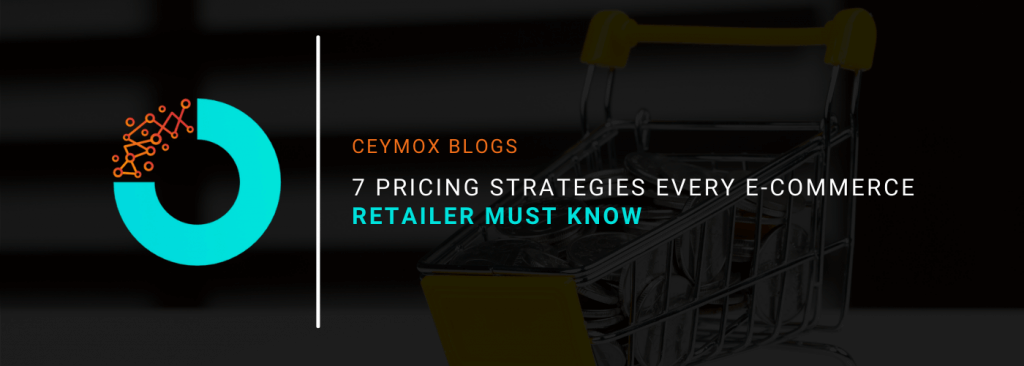
You can find many different pricing strategies for your e-commerce store. We really hope this article will be useful for you. Pitching your products at reasonable rates is highly recommended for a successful long-term e-commerce business.
Deciding the price of your products is not as easy as you believe – there are many different pricing models to consider and factors to take into account.
In this article, we will go through 7 popular pricing models which an online retailer must know. Whether you have launched your site, are ready to launch, or need to change tactics to increase sales, read out these pricing strategies.
If you are a newbie in the e-commerce industry and selling for the first time then you may be bamboozled by all the phrases flying around. So let’s know more about the pricing strategies definition.
What is a Pricing Strategy?

A pricing strategy is a method that can determine the best price for selling goods or services. So, in simple words, it’s how you decide what your products (or services) should cost.
What is the importance of Pricing Strategies?
If you are asking a customer a lot for a product you are selling, then it will obviously decrease the chances of selling. On the other hand, in case if you are charging quite less, then you may end up making huge losses. Thus, finding an accurate price is highly important if you want to run your e-commerce store for the long term.
Why do you need a Pricing Strategy?
It is a good business step to have a pricing strategy in place. It will make sure that you can make the maximum out of your sales – giving your customers value for money while maximizing your store’s revenue and profit.
How do you choose a Pricing Strategy?
There are multiple things to consider when it comes to choosing the right pricing strategy including:
- Costs: You have to take all costs into account. It includes production or manufacture cost, labour, shipping, and marketing as well. You have to make sure to cover all these costs while making a sale.
- Value for money: A very small portion of customers make a purchase if they don’t feel that they are getting value for money. You need to make sure your pricing is competitive for your niche.
- Target audience: You must have a strong knowledge of your target audience while deciding on a picking strategy. Consider whether your target audience has a disposable income to splash, or whether they are likely to be more frugal as this will also influence your strategy.
E-commerce Pricing Strategies that you must know:

Now, after knowing the basics, let’s finally know about the different pricing models:
1. Cost-Based Pricing:
It is probably the most obvious e-commerce pricing strategy but it is worth considering nonetheless. The focus of cost-based pricing is on how much profit you can make through sales. You have to consider all the costs, as we mentioned in the previous section. Thus, you have to take account of all prices, set a profit margin, and then set the price. It is a very basic, old-age model, but it still works just as well as any.
2. Penetration Pricing:
If you are a newbie in the e-commerce industry and are starting out by launching your e-commerce store then you must go through this pricing strategy.
Penetration pricing strategy includes launching a new product at a lowered price (only for a temporary phase). It is a good strategy to establish yourself in the market, gain a market share in your product niche.
The main strategy here is to attract new customers through a discounted price and let the quality make them realize that it is worth buying for even a high price (full price).
3. Loss Leader:
Loss leader is a very popular e-commerce pricing strategy. Let’s understand this strategy through an example. Suppose you visit your favourite e-commerce store and see a quite costly item for which you want discounts. You add it to your cart, looked at the price and get overjoyed at a huge bargain. You will think “Oh! I get a great discount on this item, I should grab a few more items”. Before you know, your cart is full to the brim.
If you have ever found it in a similar scenario, then you have become part of a Loss leader pricing strategy. In this strategy, the customer is lured with a discounted price and then subtly encourages to buy other items too.
4. Competitive Pricing:
It is again a tested pricing strategy, quite straight for selling pricing products. It is simple to understand. You just have to research the prices of your competitors for similar products and then accordingly setting your prices at lower rates.
As the name indicates, it keeps your prices competitive. It can be quite tricky for those brands who are just starting out, but it is an important strategy that every online retailer should know.
5. Bundles:
Now let’s know about bundle pricing. You must have checked out bundle pricing at a general or grocery store. Consider a pack of t-shirts, if individually sell, a t-shirt will cost $50 but if you buy a bundle of 3 then you can get 3 t-shirts at $120.
There are two benefits of this strategy. You can make more sales by volume and the customers will happily leave your store as they got a great deal. But make sure that you don’t end making a loss in this pricing strategy.
6. Economy Pricing:
In this pricing strategy, the rule is simple, set the prices low and make profits through increased sales. It is a good pricing strategy for those products which are potential for huge sales and are of low cost. When production costs are low, you can easily recoup the low profit through the huge volume of sales.
7. Anchor Pricing:
Last but not the least, this is another technique used by retailers. There are two different ways of using the Anchor Pricing strategy. During a sale, you can set the sale price besides the original price. Thus, the customers came to know what a deal they are getting at what discount.
Alternatively, during the off-sale time, you can simply list more expensive products just next to cheaper ones. This will draw customers’ attention to both products and encourage more sales.
Wrapping Up:
Although it sounds obvious, the product prices define the success of your e-commerce store. Having a pricing strategy in mind is really important, but it’s not something you should fret over. Pricing strategies are dynamic and can evolve over time. At Ceymox Technologies, the best e-commerce development company in India, we give you options of dynamically setting prices in your e-commerce store. Let us know your requirements.
 Hubspot SEO Certified |  Hubspot SEO II Certified |  Google Ads Search Certified |  Google Analytics Certified |
Sreehari N Kartha is a skilled Digital Marketing Analyst at Ceymox, certified in SEO. His expertise encompasses a wide range of digital marketing strategies, including managing advertising campaigns on platforms like Google Ads, Facebook Ads, Instagram Ads, WhatsApp Ads, and LinkedIn Ads. With a strong foundation in SEO and SMM, Sreehari is adept at optimizing online visibility, driving engagement, and generating qualified leads and conversions. His passion for emerging technologies, such as Crypto, NFTs, and Web3, further complements his skillset, enabling him to navigate the dynamic digital landscape.
View All Articles